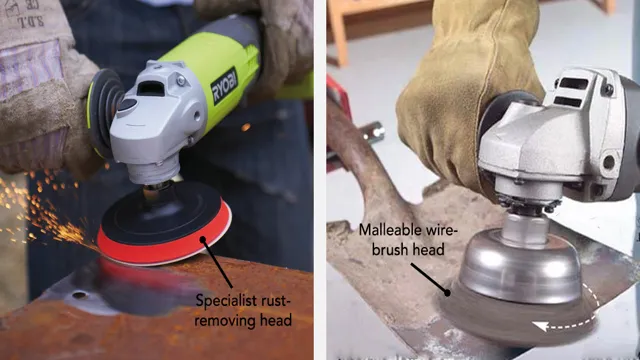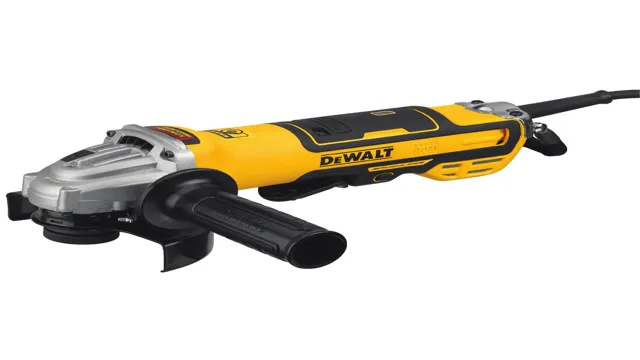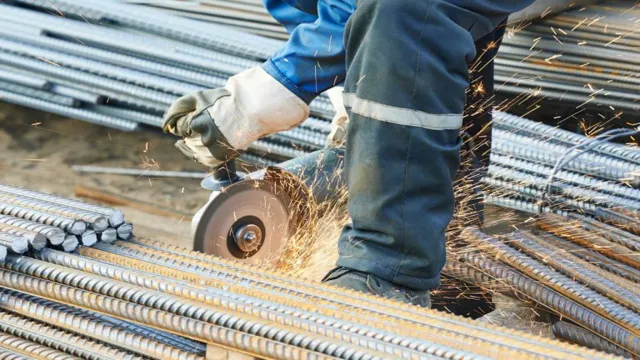What Do You Use an Angle Grinder For? Tips and Tricks for Using this Versatile Power Tool

If you’re someone who loves DIY projects or spends hours tinkering in your garage, chances are you’ve come across an angle grinder at some point. This powerful tool is a must-have for any serious DIY enthusiast or professional craftsman. But what exactly is an angle grinder, and how does it work? Picture a handheld power tool that has a spinning disc or wheel at the end of its shaft.
That’s an angle grinder. These machines come in various sizes, with different disc sizes and power output levels. An angle grinder is essentially a versatile tool that can perform a wide range of tasks, from polishing and cutting to grinding and sharpening.
The beauty of an angle grinder is its ability to handle tough materials with ease. Whether you need to cut through thick metal pipes, sharpen lawnmower blades, or grind down rusted bolts, an angle grinder is the ideal tool for the job. In this blog, we’ll break down all the different aspects of an angle grinder, from its different parts to its uses, and everything in between.
We’ll also explore the safety precautions you need to take when using an angle grinder, to ensure that you get the most out of this essential tool, without putting yourself or others in harm’s way. So, grab a cup of coffee, get comfortable, and let’s dive into everything you need to know about getting the most out of your angle grinder.
Overview of Angle Grinders
An angle grinder is a versatile tool that can be used for a variety of tasks. Its most popular use is for grinding and cutting metal, but it can also be used for polishing, sanding, and even shaping wood or stone. The tool is designed with a rotating disc that can spin at high speeds, allowing it to make precise cuts and smooth out rough edges.
It’s a handy tool for anyone who works with metal or needs to make precise cuts in other materials. The main advantage of an angle grinder is that it can be used with a variety of different discs, each with their own unique characteristics. Depending on the task at hand, you can quickly and easily swap out the disc and get back to work.
So, whether you’re working on a DIY project at home or a professional job site, an angle grinder is a useful tool to have in your toolbox.
Components of an Angle Grinder
An angle grinder is a versatile power tool that can be used for a variety of tasks, including cutting, grinding, and polishing. It consists of several components, including a motor, a disc or wheel, a guard, a handle, and a switch. The motor is the heart of the angle grinder and provides the power to turn the disc or wheel at high speeds.
The disc or wheel is the cutting or grinding tool that is attached to the motor shaft, and it comes in many different types and sizes depending on the task at hand. The guard is a safety feature that protects the user from debris and sparks that may be thrown off during operation, while the handle provides a comfortable and secure grip. Finally, the switch is used to turn the grinder on and off, allowing the user to control the speed and direction of the disc or wheel.
With all these components working together, an angle grinder can be a valuable addition to any workshop or toolbox.

Types of Angle Grinders
Angle grinders are versatile tools used for grinding, cutting, polishing, and sanding just about any material, from metal to stone to wood. They are handheld and powered by electricity, compressed air, or gasoline. Angle grinders are available in different sizes, with the most common being
5-inch and 7-inch. The size of the disc determines the size of the grinder. The smaller,
5-inch grinders are ideal for small to medium-sized projects, while the larger, 7-inch grinders are suitable for big projects, such as cutting through thick metal or concrete. It’s essential to choose the right type of angle grinder for your project, as each one has distinct features that make it suitable for specific tasks. For instance, a corded angle grinder is best for heavy-duty work, while a cordless angle grinder is more portable and ideal for light-duty work.
Overall, angle grinders are powerful tools that can quickly get the job done, regardless of the material and type of work involved.
Uses of Angle Grinder
Angle grinders are versatile tools that can be used for a variety of purposes both in residential and commercial settings. One of the most common uses of an angle grinder is to cut through metal, tiles, bricks, or concrete. With the right blade, an angle grinder can make quick work of these materials, helping to speed up construction or renovation projects.
Angle grinders can also be used for smoothing out rough surfaces or removing surface coatings. They are often used in auto shops to remove rust from car bodywork or in metalworking shops to grind down rough edges. Additionally, angle grinders can be used for woodworking, sanding, and polishing – making it a useful tool for DIY enthusiasts and professionals alike.
With its versatility and power, an angle grinder can be an invaluable addition to any toolkit or workshop.
Metalworking
Metalworking is a skilled craft that involves shaping raw metals into useful and functional objects. One of the most essential tools in the metalworking arsenal is the angle grinder. This versatile tool is capable of cutting, grinding, sanding, and polishing metal surfaces to perfection.
Whether you’re working on a DIY project, repairing an old car, or creating a custom piece of metalwork, an angle grinder can help you achieve your goals quickly and efficiently. With its powerful motor and various attachments, an angle grinder can remove rust, burrs, and paint from metal surfaces, smooth out rough edges, and even create intricate designs. Plus, thanks to its compact size, an angle grinder can reach tight spaces that other tools can’t.
So if you’re serious about metalworking, investing in a high-quality angle grinder is a must-have.
Masonry Work
If you are in the masonry business, then an angle grinder can be a great addition to your tools. Masonry work is all about precision and quality, and an angle grinder can help you achieve both. One of the primary uses of an angle grinder in masonry work is to cut and shape bricks and concrete blocks.
With the right attachment, you can create clean, precise cuts in no time. An angle grinder can also be used to remove mortar from bricks and blocks, allowing you to reuse them and save money. Its versatility doesn’t end there; an angle grinder can also be used to smooth rough edges on stone and concrete surfaces, making them easier to work with and more aesthetically pleasing.
So if you are looking to take your masonry work to the next level, consider investing in an angle grinder. It’s a tool that will save you time, increase your precision, and overall make your work easier and more efficient.
Woodworking
Woodworking enthusiasts may find angle grinders very useful in creating intricate shapes and precise cuts on wood. An angle grinder can easily remove excess material from a block of wood or shape it to a desired form. It can also polish wooden surfaces, making them look smoother and shinier.
With the right attachments, an angle grinder can even carve intricate designs on the wood, providing endless possibilities for creativity. However, woodworking with an angle grinder can be dangerous if the user is not cautious. It is important to wear protective gear and follow safety guidelines when using this tool.
With proper handling, an angle grinder is a versatile tool that can help woodworkers create their desired designs with ease.
Safety Tips when using Angle Grinders
Angle grinders are versatile tools that can be used for a wide variety of tasks, from cutting and grinding metal to sanding and polishing surfaces. When using an angle grinder, it’s important to take safety precautions to prevent injury and damage to property. One of the most important safety tips to keep in mind is to always wear protective gear, including eye and ear protection, gloves, and a dust mask.
It’s also essential to choose the right type of blade or attachment for the job you are doing and to avoid using damaged or worn-out blades. Additionally, make sure to keep your work area clean and free from clutter, as this can contribute to accidents. By following these safety tips and using your angle grinder with care, you can get the job done quickly and efficiently without putting yourself or others at risk.
Wear Protective Gear
Angle Grinders When using angle grinders, safety should always be the top priority. One of the most important safety tips is to wear protective gear. This includes safety glasses or goggles, a dust mask, gloves, and earplugs.
Safety glasses or goggles protect your eyes from flying debris or fragments while a dust mask is essential to avoid inhaling metal particles. Gloves should be worn to prevent cuts and burns, and earplugs can protect your hearing from the loud noise produced by angle grinders. Keep in mind that protective gear may vary depending on the job you are doing and the materials you are working with.
It’s always better to err on the side of caution and wear too much protective gear than too little. Remember, accidents happen in the blink of an eye, so taking the time to put on protective gear can prevent serious injuries and even save your life.
Check the Equipment before Use
Angle grinders can be incredibly useful tools, but it’s important to check the equipment before use to ensure that it’s safe and ready to go. Before you begin working with an angle grinder, take a few moments to inspect the wheel and guard for any signs of wear or damage. Make sure that the power cord is in good condition and that there are no frays or other signs of damage that could put you at risk.
Additionally, it’s always a good idea to wear appropriate personal protective equipment, such as safety goggles, a face shield, and gloves. By taking the time to check your equipment and stay safe, you can avoid accidents and protect yourself from serious injury. So before you start using your angle grinder, be sure to follow these safety tips to keep yourself and others safe from harm.
Conclusion
In conclusion, an angle grinder is the ultimate tool for any DIY enthusiast or professional tradesperson. With the ability to cut, grind, polish, and sand almost any material, this versatile powerhouse allows you to get your hands dirty and create some truly impressive masterpieces. From slicing through metal pipes to shaping wood for bespoke furniture, an angle grinder can handle any task with ease.
So, whether you’re a seasoned DIY pro or just starting out, an angle grinder is an essential tool that will save you time, effort and offer endless possibilities for your projects. So go ahead, unleash the power of the angle grinder and let your creativity run wild!”
FAQs
What is an angle grinder and how does it work?
An angle grinder is a handheld power tool used for cutting, grinding, and polishing different materials such as metal, tile, and stone. It works by rotating a disk-shaped blade or attachment at high speeds.
Can angle grinders be dangerous to use?
Yes, angle grinders can be dangerous to use if not handled properly. They can potentially cause injuries such as cuts, lacerations, burns, and even fractures. It is important to use proper safety equipment and follow manufacturer’s instructions when using an angle grinder.
What are the different types of blades and attachments available for angle grinders?
There are several different types of blades and attachments available for angle grinders, including cutting discs, grinding discs, wire brushes, sanding discs, and polishing pads. Each type is designed for a specific task or material.
How do you change the blade or attachment on an angle grinder?
To change the blade or attachment on an angle grinder, first, make sure the tool is unplugged or the battery is removed. Then, loosen the nut or bolt holding the current blade or attachment in place. Remove the blade and replace it with the new one, making sure it is securely fastened before using the tool.
Can angle grinders be used for woodworking projects?
Yes, angle grinders can be used for woodworking projects, such as shaping and carving wood. However, specialized blades or attachments may be needed for this task, and proper safety precautions need to be followed.
What is the maximum RPM for an angle grinder?
The maximum RPM (revolutions per minute) for an angle grinder can vary depending on the brand and model, but most range between 5,000 and 12,000 RPM. It is important to check the manufacturer’s specifications and use the tool within the recommended RPM range.
How do you maintain and clean an angle grinder?
To maintain and clean an angle grinder, first, ensure the tool is unplugged or the battery is removed. Then, inspect the tool for any damage and clean any debris or dust that may have accumulated on the disc or attachment. Lubricate the tool’s moving parts and replace any damaged or worn parts as necessary.







